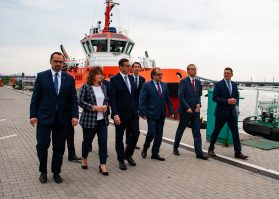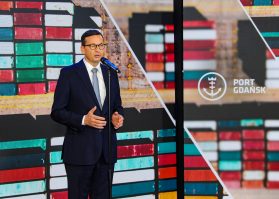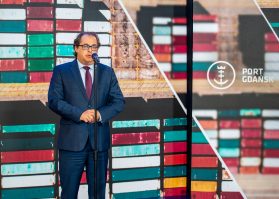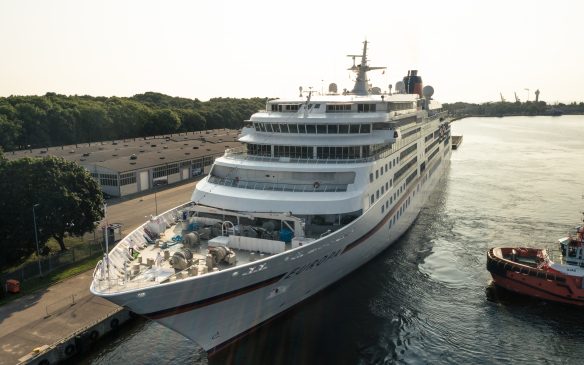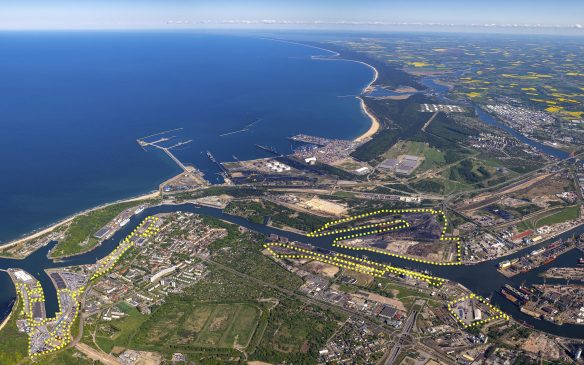DCT Gdansk and the Port of Gdansk enter a new era of container handling in the Baltic Sea
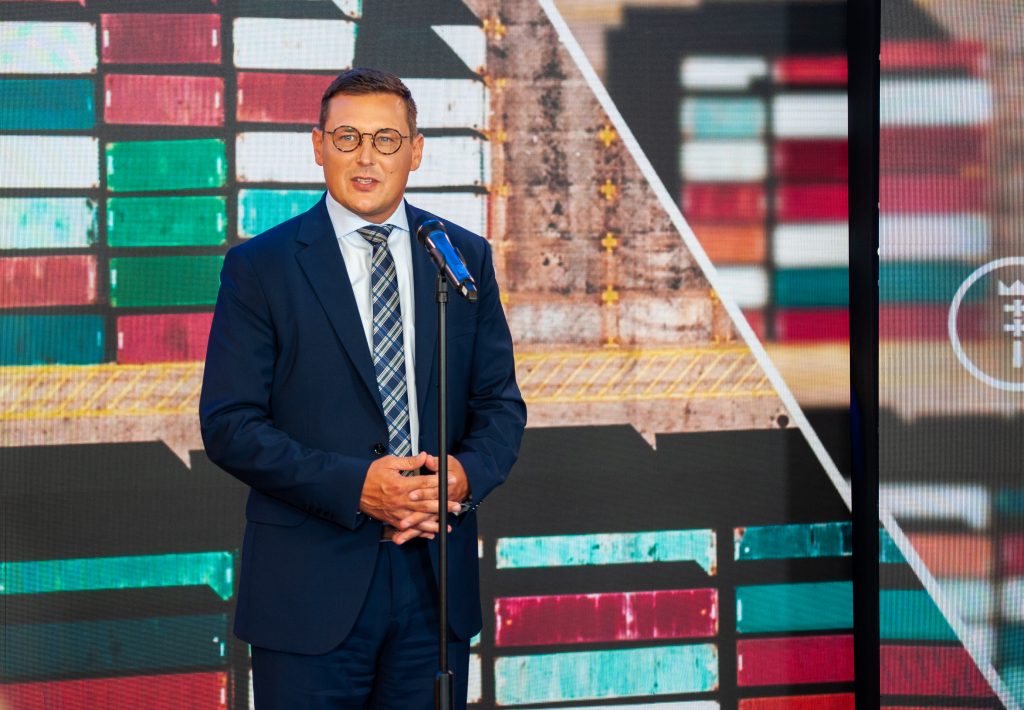
On 18 September 2020, Port of Gdansk Authority S.A. announced a competitive procedure to select the lessee or lessees for those areas to be created through land reclamation of the marine area located within the administrative boundaries of the Port. On 23 July 2021 the results were officially announced. The Competition Committee accepted the bid of DCT Gdansk S.A.
DCT Gdansk is the biggest container terminal in the Baltic Sea. Since the start of the terminal operations in 2007, two deep-water terminals have been built (T1 and T2 – opened in 2007 and 2016 respectively) with a total capacity of 3 million TEUs (Twenty-Foot Equivalent Units).
The contract award is another milestone in the history of DCT Gdansk: from its humble beginnings to achieving the position of one of the 15 largest container terminals in Europe in 2020.
Thanks to the construction of the new Baltic Hub 3 terminal, a third deep-water quay will be built in the port area, thus increasing the handling capacity of DCT Gdansk by 1.5 million TEUs to the total of 4.5 million TEUs per year. As part of an investment project worth 450 million EUR, a 717-metre-long deep-water quay with a depth of 18m and a 36 hectare yard will be built.
In addition, the Baltic Hub 3 project will involve the purchase of 7 quay cranes able to load and unload the world largest vessels and 20 automated RMG cranes for the yard, which will be remotely operated by equipment operators from ergonomically designed work spaces. This will allow a much safer, modern and convenient working environment to be maintained all year round.
The construction of the new terminal is scheduled to start in H2 2022, and its commissioning is planned for mid-2024.
Following the completion of Baltic Hub3, DCT Gdansk will become one of the largest container terminals in Europe in terms of handling capacity and will invariably serve and support both the dynamically developing Polish economy and the markets of Central and Eastern Europe as well as the Baltic States.
“Over the last five years, we have placed great emphasis on improving the access infrastructure to Polish seaports, renovation and construction of new quays, and deepening of water lanes. Today, we can enjoy the fruits of our efforts, and the Baltic Hub 3 project in Gdansk is just an example. The Port of Gdansk is now able to welcome the largest container ships in the world. Thanks to the expansion of the DCT terminal, the Port of Gdansk will maintain its leading position among the Baltic ports. Such investments as Baltic Hub 3 strengthen the position of the Polish economy. A 717-metre-long deep-water quay with a depth of 18m and a yard of more than 36 hectares will be built with the capacity to handle an additional 1.5 million TEUs per annum. The project is worth approximately 2 billion PLN. This terminal is the heart of the port and its development means the development not only of the port itself, but its facilities as well,” says Marek Gróbarczyk, Deputy Minister of Infrastructure.
“Selecting a bid from such a conscious investor as DCT of the PSA group, which is one of the largest container terminal operators in the world, testifies to the enormous potential of the Port of Gdansk and the Polish economy. This is the outcome of over two years of strenuous team efforts which, in the first place, involved working on amendments to the Act on Sea Ports and Harbours so as to make it possible at all to lease reclaimed land before it is even created. The team also worked on the amendment to the Company’s Articles of Association and, as the final step, on the development of a very complex, yet transparent procedure. And they did, where thanks to such investments the Port of Gdansk will reach the top division of European ports. Not only are we the largest Polish port, but today we are becoming the Super Port of Gdansk, something which Poles can be truly proud of. We prove that Poland is a country that can successfully compete on the logistics and transport market with the largest ports in Europe. This is another great success and another tangible result of our hard work. We prove that the Port of Gdansk offers opportunities that are worth taking. Thanks to the construction of the Baltic Hub, the Port was, is and will be Poland’s window on the business world,” says Łukasz Greinke, President of the Port of Gdansk.
“The construction of the third quay of our Baltic Hub Terminal marks the opening of a new era in container handling. DCT Gdansk is a true twenty-first century terminal, and the Baltic Hub Terminal 3 development will bring in the latest low-carbon technologies, of which any European port would be proud. Even the concrete used for construction will have a reduced carbon impact. Baltic Hub Terminal 3 will greatly enhance the service we offer customers and is a significant boost to attracting new services or shipping alliances, and supporting the growth of the Polish and surrounding economies,” says Charles Baker, CEO of DCT Gdansk.
“Thanks to Baltic Hub Terminal 3, Poland can continue to compete with western European ports such as Hamburg and Rotterdam. Adding a third quay will allow the terminal to serve not only the Polish market, but also the entire Baltic region as well as Poland’s land-locked neighbours. Historically, when we talked about major ports in North Range, it was always the Hamburg – Le Havre Range. DCT Gdansk, growing rapidly, has extended that range to Gdansk, Poland, and the Baltic,” says Charles Baker.
According to Zsolt Katona, East Europe Managing Director Maersk, Gdansk is an important part of Maersk’s network, with clear value for the growing market in CEE and Russia.
“In January 2010, Maersk and DCT started a revolutionary direct service connecting the Far East and Gdansk. Since then we have witnessed strong growth by the terminal, and today DCT has become Maersk’s partner in creating E2E solutions to the customers. With the construction of BH3, we are very happy to see DCT continuing its investments in future capabilities and actively addressing the supplier chain bottlenecks,” says Zsolt Katona.
INVESTMENT DETAILS AND FINANCING
Announced by ZMPG S.A. in September, the competition procedure achieved good marks in the market, for ‘checking’ the potential of this port investment – in particular the waters where further development of the deepwater terminal is planned.
DCT was chosen in a non-discriminatory, competitive procedure managed by the Port of Gdansk Authority to lease the area to be reclaimed by DCT and where the new Baltic Hub 3 container terminal will be built, located east of the existing T1 quay. The development is expected to bring investments into the region worth 2 billion PLN (about 450 million EUR) and will be financed solely by DCT’s own funds and from external lenders.
GREEN SIDE OF THE INVESTMENT
DCT Gdansk takes its environmental responsibility very seriously, adopting features such as eco- friendly landside and portside equipment or using special concrete to minimise CO2 emissions. Therefore, DCT also conducts environmental impact studies and implements mitigation measures for any new developments. As a responsible port hub, DCT Gdansk reaffirms with its new investment it is a strong commitment to balance environmental protection with port development.
The Port of Gdansk Authority and DCT Gdansk emphasize that the investment will be implemented with respect for the environment and the local community.
LOCAL COMMUNITY
The new terminal will be built entirely on the water, and its structures will adhere to T1, thereby continuing investment in the sea and away from the beach. The same concept guided the construction of the T1 terminal. DCT Gdansk and the Port of Gdansk Authority are responsible developers, aware of environmental issues and respecting the needs of local communities. Therefore, they are going to take all precautionary measures to protect the environment, marine life and habitats within the area of the Baltic Hub 3. The Stogi Beach, important for environmental reasons and the needs of the local community, will remain intact and accessible to visitors.
About DCT Gdansk:
DCT Gdansk was launched in 2007 and has the handling capacity of 3 million TEUs annually. The terminal handles over 600 ships annually, including 100 calls of the largest container ships in the world. In 2020, DCT Gdansk handled over 1.9 million TEUs, and on 8 April 2021 reached 15 million TEUs of total volume handled since its inauguration 14 years ago.
The terminal has a significant impact on the economy; it employs over 1000 people, with over 50% living in Gdansk or its vicinity. In addition, it generates over 12 billion PLN as state budget revenues from VAT, excise and customs duties. Regardless of the Baltic Hub 3 project, DCT Gdansk continues other large investment programmes, including the extension of the railway siding (from 4 to 7 tracks – each 750 m long).
DCT Gdansk also engages to benefit local communities while clearly defined, measurable sustainability goals are an integral part of DCT’s business operations.
The terminal is owned by PSA International (40%), the Polish Development Fund (30%) and IFM Global Infrastructure Fund advised by IFM Investors (30%). PSA International is a leading port group and trusted partner to cargo stakeholders all over the world. With flagship operations in Singapore and Antwerp, PSA’s global network covers more than 50 locations in 26 countries around the globe. The Polish Development Fund (PFR) Group is a financial group which offers instruments supporting the development of companies, local governments and individuals, and invests in sustainable social and economic development. IFM Investors is a global institutional funds manager with 118 billion USD under its management (as at 31 March 2021).
About the Port of Gdansk:
The Port of Gdansk is the fastest growing European port of the last decade. In the ranking of European ports today it lies in 18th position, and in early 2021 it became one of the three largest ports in the Baltic Sea. The first quarter of 2021 confirmed its high ranking, taking first place in the Baltic Sea in terms of container handling. Over 50 million tonnes of goods are handled at the port’s quays each year. The Port of Gdansk covers an area of over 790 hectares, where over one hundred companies of various industry profiles are present (including petrochemical, power engineering, agri-food and construction businesses), of which over 27 carry out their handling operations by sea.
Port of Gdansk Authority S.A. was established in 1998 as a commercial company and has been operating under the Act on Sea Ports and Harbours and the Code of Commercial Companies. The company shareholders are: State Treasury, Gmina of Gdansk and eligible employees. The activities of Port of Gdansk Authority S.A. include property and port infrastructure management, port development planning, construction, expansion, maintenance and modernisation of port infrastructure.
Port of Gdansk Authority S.A. is a member of many national and international organisations. It works with: ESPO European Sea Ports Organisation, whose main goal is to influence the maritime policy of the European Union; Cruise Baltic, promoting the Baltic Sea region among tourists, shipowners and tour operators; the National Chamber of Maritime Economy, integrating the entities operating in the maritime economy and representing them before various institutions and state and local administration authorities.
Contact for the media:
Anna Drozd
Press spokesperson of the Port of Gdansk
anna.drozd@portgdansk.pl
phone: (+48) 727 064 605
Katarzyna Frankiewicz
Communication Specialist DCT Gdansk S.A.
katarzyna.frankiewicz@dctgdansk.com
phone: (+48) 609 320 437

